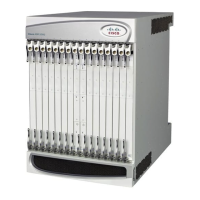Cisco® ASR 5000 Platforms Introduction
▀ Characteristics of the System
▄ Cisco ASR 5000 Series Product Overview
Characteristics of the System
This section provides an overview of some of the key characteristics of the system. Detailed information for these
characteristics is provided in subsequent chapters of this guide.
Carrier-grade Hardware Design
NEBS Level 3 Compliant components
UL certified
Five 9s availability
Local alarming and alarm cut-off capabilities
High availability design (less than 4.35 minutes of downtime per year)
Redundancy
1:1 Switch Processor Card (SPC)/System Management Card (SMC) redundancy
1:n Packet Services Cards (PSC/PSC2) redundancy - allowing redundancy of multiple active to multiple
redundant for up to 14 total packet processing cards
Important: 1:1 redundancy is supported for these cards however some subscriber sessions and
accounting information may be lost in the event of a hardware or software failure even though the
system remains operational.
1:1 card-level redundancy for Switch Processor Input/Output (SPIO), and all types of line cards
1:1 port-level redundancy for SPIO and all types of line cards
Integrated hardware and software redundancy with automatic failover features
Optional session recovery support for the following call types:
- WiMAX ASN GW services supporting simple IP, Mobile IP, and Proxy Mobile IP
- PDSN services supporting simple IP, Mobile IP, and Proxy Mobile IP
- HA services supporting Mobile IP and/or Proxy Mobile IP session types with or without per-user Layer 3
tunnels
- GGSN services for IPv4 and PPP PDP contexts
- MME services for LTE/SAE networks and 3G services
- LNS session types
Optional Interchassis Session Recovery
Hot swappable cards, allowing dynamic card replacement while the system is operational
Load sharing, hot swappable - 48VDC power filters with redundant power circuitry throughout
High Capacity Design
Self-healing 320 Gbps packet-based Switch Fabric
System Management Bus

